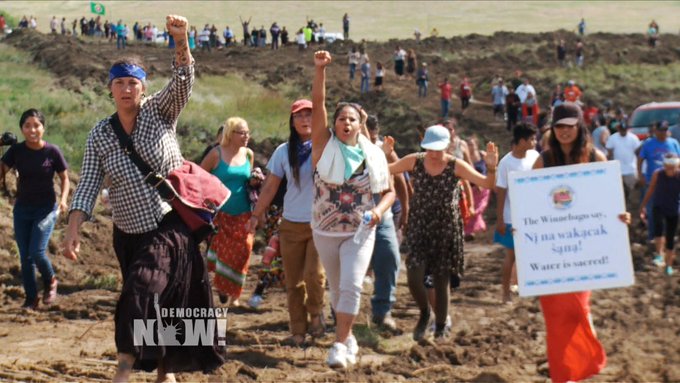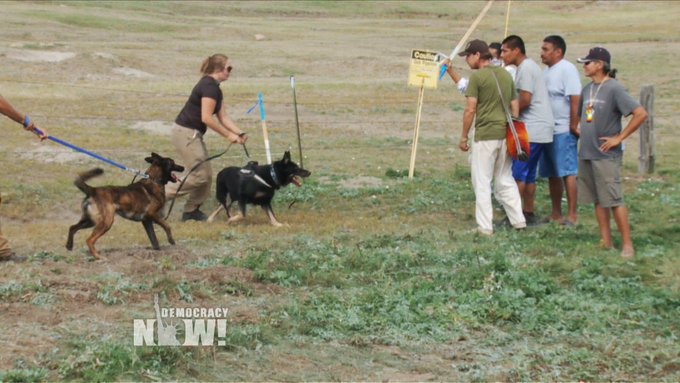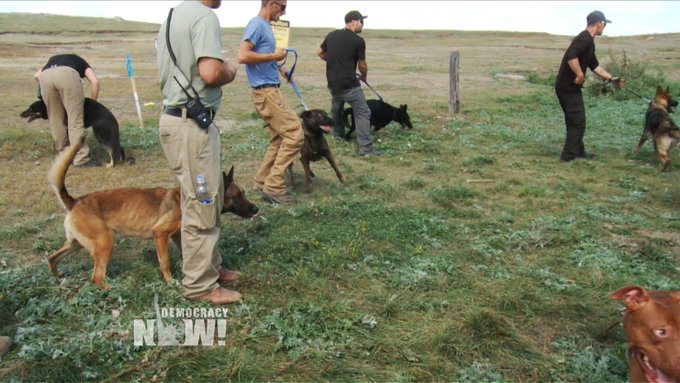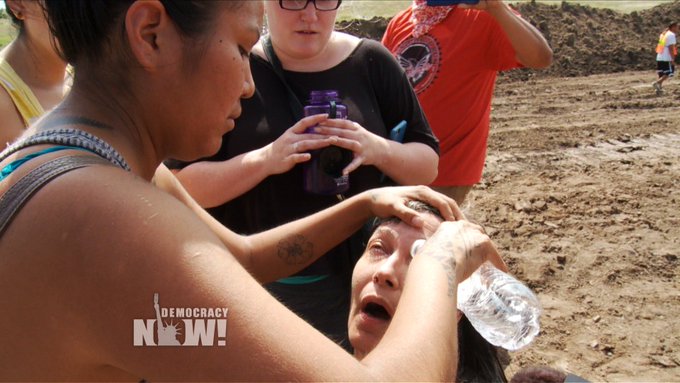Thank you to https://www.treemedia.com/ for this wonderful interview.
Tag Archives: native American
Dakota Access Pipeline Company Attacks Native American Protesters.
From Democracy Now:
On September 3, the Dakota Access pipeline company attacked Native Americans with dogs and pepper spray as they protested against the $3.8 billion pipeline’s construction. If completed, the pipeline would carry about 500,000 barrels of crude per day from North Dakota’s Bakken oilfield to Illinois. The project has faced months of resistance from the Standing Rock Sioux tribe and members of nearly 100 more tribes from across the U.S. and Canada.
Democracy Now! was on the ground at Saturday’s action and brings you this report:
Photos from Saturday’s Protest
Cross-posted for educational purposes from: http://www.democracynow.org/2016/9/4/dakota_access_pipeline_company_attacks_native
Spirit Wins and Media Lies Lose at Standing Rock Protest
“We are tipis going up to see the stars. Enjoying the campfire with drums in the distance. Who can ask for more this very blessed night.” ~~An Elder at the Standing Rock Main Camp, Cannon Ball ND
Smells of sweet burning sage linger in the late evening and drift over the main camp on Highway 1806 at Cannon Ball North Dakota. Junior Cuero of the San Diego Campo Reservation chants the Bird Song, a mesmerizing, meditative and repetitive song of respect and honor to the Standing Rock people. A gourd rattle accompanies this ancient chant; a message given to the people by the Creator. Creator sent a bird to teach the People how to sing and dance and treat each other with empathy and not indifference. The sun is setting, bathing the campsite in warm light as the prairie winds begin to calm, and people gather around the campfire, feet tapping in rhythm.
There are two camps. One is located within the “official” reservation boundary and the second “main camp” with the majority of the protesters is located on U.S. Army Corps of Engineer’s land just north of the Cannon Ball River. The North Dakota Department of Emergency Services says it is not on tribal property, but the original treaty line was moved in 1889, so if you support broken treaties, you could call it illegal. In this case legality is in the eye of the beholder.
The Dawes Act and the Allotment Act opened the reservations throughout the United States to settlement by non-Indians. The tribe maintains jurisdiction on all reservation lands, “including rights-of-way, waterways, and streams running through the reservation.” On paper, that is.
See the history of the Standing Rock Sioux Reservation and learn more about the broken Fort Laramie Treaty that arbitrarily moved boundaries and tried to divide the Sioux Nation.
Standing Rock lies just south of the pipeline’s path under the Missouri River. How do you stop an oil spill at a boundary drawn on a map? Ask the people of Saskatchewan, who are facing 66,000 gallons of heavy crude from a broken pipeline owned by Husky Energy, Inc. It is making its way downstream and threatening the drinking water of several communities.
Despite local media accounts to the contrary, this gathering of Nations to protest the Dakota Access Pipeline are Spirit Camps of thoughtful prayer. There is no need to prolong the misinformation and outright lies perpetuated by the North Dakota Forum News Service. A governor steeped in the sticky flow of oil and money that has all but ruined portions of the North Dakota landscape feeds the news cycle with threats and lies about behavior at the encampments and issues emergency orders.
Truth about what fuels the reactions of authorities can be found in the discarded detritus of the failed oil boom. Abandoned RVs form small mountains in salvage yards, wells are shut down, man camps are ghost towns, and the promises of great wealth are only memory. The loss of oil revenue dollars provokes great fear in the offices of politicians. The Dakota Access Pipeline is really another name for the “abandoned” Keystone XL Pipeline and the goal is to wring every last drop of Bakken crude from North Dakota.
Authorities are reacting with anxiety that the pipeline will be compromised, and believe that concrete barricades along the main road to Standing Rock will stop the people from coming to protect their life source; water flowing from the mighty Missouri river.
But people continue to come, taking the long detour meant to complicate their journey to the Spirit Camp and reduce business at the Prairie Knights Casino and Hotel. But the authorities, despite the show of force at a “safety checkpoint” and rerouting of traffic on 1806 from Bismarck to Standing Rock, have failed. The hotel is almost full and the diversion along Highway 6 is spectacularly beautiful. Those who have purpose and appreciate the land and all it has to offer do not mind this “detour.”
Descendants of the Massacre at Wounded Knee by the Seventh Cavalry come. Young riders, many teenagers, come on their horses—they are some of the Big Foot Riders who travel 300 miles every year to Wounded Knee to pay respect to the ancestors who were massacred by the U.S. 7th Calvary Regiment. They, along with tribes from across the continent, do not want this pipeline that would involve 200 water crossings and pass through 300 sacred sites. They come. They come by car.
They come by horse.
They come on foot.
They are still coming.
Read Winona LaDuke’s excellent analysis of all that is at stake, “What Would Sitting Bull Do?”
I am not sure how badly North Dakota wants this pipeline. If there is to be a battle over the pipeline, it will be here. For a people with nothing else but a land and a river, I would not bet against them. The great Lakota leader Mathew King once said, “ the only thing sadder than an Indian who is not free, is an Indian who does not remember what it is to be free.”
Let’s for a moment reject the profane response of North Dakota authorities and focus instead on the sacred.
So many have traveled great distances to stand in solidarity. Many Nations now united as one.
An Elder from the Cheyenne River Sioux Tribe talks of raising his granddaughter in the old ways. Seeing the tipis fills him with “cante waste”— “heart felt good.” M. Jay Cook is a member of the Bureau of Indian Affairs (BIA) School Board and says that sometimes raising his granddaughter “is my only motivation to live.” I receive a text from him one morning and a photo that is incredibly evocative of what is at stake here. He writes of the campfires and “hearing memories of growing up in iron lightning” as the stars speak to him of days gone by. He intends to “face the storm (oil) like the Tatanka (Buffalo) Nation.”
Photo by M. Jay Cook
Hazel Red Bird is 91 years old and a regal presence around the campfire. Many stop to greet her and share stories of growing up in Fort Yates. Red Bird is now back home at Standing Rock after living a good part of her life in Wisconsin. She is a true warrior woman, having enlisted in the Army Air Corps during World War II to train as a nurse at St. Mary’s School of Nursing in Pierre, South Dakota. The Great War ended just as her training did, and she began her working life as a registered nurse in the civilian white world.
Hazel Red Bird by Georgianne Nienaber
Red Bird surveys the gathering and says she is “amazed, thankful and humbled.” Then she glances down at the writer’s notepad to make certain those three words are written accurately.
“I am amazed because I didn’t think I would live long enough to witness this unity and resiliency among the Nations.”
Red Bird is quiet for a moment as her eyes narrow and she surveys the movement of the people who have gathered around the green tent that serves as a food and information center.
“I am thankful that I have lived 91 winters and humbled that prayers have been answered.”
At 91, this elegant Lakota woman still projects a warrior’s stance. There is more to learn about this fascinating woman who is also a repository of the Lakota language, and you can read more here.
There are other spiritual warriors who have gathered in joyful celebration and unity. Several young women from the Crow Creek Sioux Tribe wanted to make it very clear that they “are standing for our water.” Their ancestors fought and died along the northern and eastern shores of the Missouri River.
Renee Gonzales by Georgianne Nienaber
The Crow Creek Indian Reservation was established by executive order following what was known as the Minnesota Uprising, as a prison camp for the exiled Isanti Dakota and Winnebago people. These were the survivors, mostly women and children, of the largest known public execution in American History, “The Hanging of 38 Dakota Men at Mankato Minnesota.” From 1863 to 1866 approximately 300 died at Fort Thompson suffering from starvation, sickness, disease, exposure, hardship, and heartache.
A federal judge will rule on the legality of the Dakota Access Pipeline on September 9. It remains to be seen whether the traumatic past will be repeated and define the present. How much can be endured; how much more can be stolen? This is a spiritual battle for generations to come. Clean water and air is a right, not an option.
The bird song says this is true.
Anonymous tip says wild horses are being slaughtered by the thousands
We are sharing this anonymous tip in hopes legal action or rescue will follow to save the thousands of horses who are still alive.
#TakeAction to demand horse slaughter stop now!
Email Secretary Sally Jewell ( Secretary_jewell@ios.doi.gov ). The Secretary of Interior oversees the Bureau of Indian Affairs. You can also write her a letter. Here is her address:
The Honorable Sally Jewell Secretary of the Interior
U.S. Department of the Interior
1849 C Street,
NW Washington,
DC 20240E
Please Contact your Congressional Rep (
http://www.contactingthecongress.org/search.html ) to request they intervene on your behalf to stop the slaughter.
Join the movement to Protect Mustangs by liking the Facebook page: www.Facebook.com/ProtectMustangs Check the page daily and invite your friends to join the movement to protect mustangs!
We are working for the wild horses on Twitter too so Join up at www.Twitter.com/ProtectMustangs You can also join our Founder and Executive Director, Anne Novak, on Twitter at www.Twitter.com/theAnneNovak There is a lot we can do together to Protect Mustangs!
Please share this video so people will learn what is going on. Then they can demand change and legal action to stop the slaughter of thousands of wild horses!
Video Copyright Protect Mustangs, 2015, all rights reserved. Photo copyright Christina Lynn Williams Photography
Go to www.ProtectMustangs.org for more information on wild horses.
Our non-profit mission is to protect and preserve America’s native and wild horses. www.ProtectMustangs.org
Info about Native American horses selling at NV livestock auction Sat
Just called the livestock exchange, guy said they just finished counting all the horses and his numbers are approximate:
Viewing between 8-10 Saturday morning on site
selling by the head or lot, not by the pound
Approx 35 mares + babies together, will be sold singly not as a lot
Approx 40 mares in several lots (14, 17, 19)
25-30 mares no babies singly
25-30 geldings singly
Approx 75 big “old” studs to be sold in several lots
Approx 20-30 yearlings and weaned foals sold singly
All horses have brands except a few and except some babies
Auction starts at 11:00
Payment via cash, Visa or MasterCard only
Nevada tax = 7.6%
The lots will be sold at the pens – those horses will not be brought through the arena, everyone will walk to the pens and bid there
If we’re bidding, we need to register
27 owners represented in these 500 horses
I just added those numbers and it only comes to 275, so not sure about the other 225 horses that would make a total of 500 but at least we get the idea
An elder’s wisdom
There is an ancient Indian saying that something lives only as long as the last person who remembers it. My people have come to trust memory over history. Memory, like fire, is radiant and immutable while history serves only those who seek to control it, those who douse the flame of memory in order to put out the dangerous fire of truth. Beware these men for they are dangerous themselves and unwise. Their false history is written in the blood of those who might remember and of those who seek the truth. ~Floyd ‘Red Crow’ Westerman
(Special Thanks to Marjorie Farabee for sharing this.)













